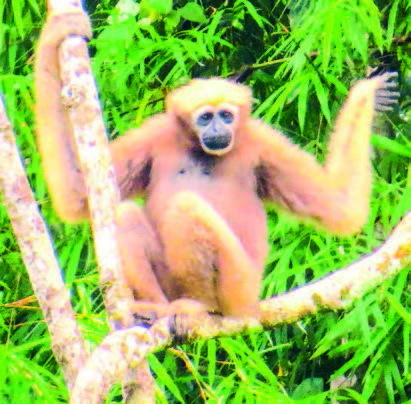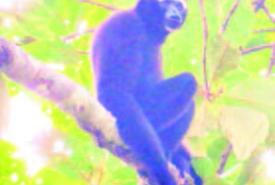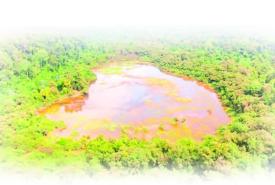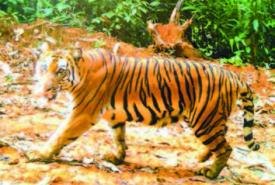By NyaungU Phee
MYANMAR is rich in natural forests, lakes, ponds, rivers, streams, waterfalls, springs, mountains, and seas. There are over 60 natural protected lands, wildlife sanctuaries, national parks, and botanical gardens in the country. Htamathi Wildlife Sanctuary is one of the ASEAN Heritage Site lists and is home to wild animals that provide environmental conservation and biodiversity. Htamathi Wildlife Sanctuary goes well with the beauty of the Chindwin River and is also as beautiful as the Amazon rainforest, and it protects wild animals. Being an evergreen forest, Htamathi Wildlife Sanctuary is similar to the Amazon rainforest, which extends over nine countries.
Amazon rainforest is rich in rivers and streams, representing over a half of the total area of remaining rainforests on Earth. It controls global climate changes, benefits human beings and the Earth, and constitutes its single most significant reserve of biological resources. The Amazon rainforest contains over 390 billion individual trees comprised of over 16,000 different species. However, these numbers are drastically declining due to alarming deforestation rates and other climate change-related threats.
A must-visit site
Htamathi Wildlife Sanctuary is as charming as the Amazon rainforest, which contains many rivers, streams, and lakes. It is higher in the eastern part of Nwetamein Hill and lower in the western part of Chindwin Valley, so there are many lakes, ponds, and streams. Htamanthi Wildlife Sanctuary is home to 57 species of mammals. They include 32 bird species, 67 fishes, 77 species of amphibians and raptile animals, 432 plants, 19 herbal plants, 14 types of bamboo, eight types of canes, 23 aquatic plants, 18 grass, and 16 orchids, as well as other rare animal species and roofed turtles. Being an evergreen forest and moist upper mixed deciduous forest, it is evergreen in three seasons. It is the best place for nature lovers.
A pride for the country
Htamathi Wildlife Sanctuary was recognized as a wildlife sanctuary in May 1974, and the administrative office was established in Homalin Township on 1 September 1994 to operate wildlife conservation activities. It was recognized as an ASEAN heritage park on 8 October 2019. It is situated in Khamti and Homalin Townships in Khamti District of Sagaing Region. It stretches 53,456 acres (830.4 square miles). It is located beside the Chindwin River, which flows from north to south, and Uru Creek, which flows from east to south. It boasts the world’s rarest wild animals, such as Indian (or Bengal) tigers and other endangered species, and it is also a proper place to conduct biological research and provide inhabitants for rare animals.
Wildlife sanctuary, treasure house for country
The forests play a crucial role in fulfilling the country’s rice bowl. A nation with millions of forests and trees is prosperous in wild animals and botanical plants and can earn revenues from the forest products and agriculture and livestock breeding sectors. Moreover, it can create jobs for locals with the help of the ecotourism industry. With the existence of wild animals, medicines can be produced using herbal plants and roots, new fish species can be bred in the fishery resource sector, research can be done by conserving the domestic fish species, and foreign income can be received by producing value-added forest products. Conservation of wild animals is a symbol of the dignity of the country. Wildlife sanctuaries benefit the climate and become treasures for the country. As Htamathi Wildlife Sanctuary possesses the tradition and culture of locals, natural resources, Myanmar roofed turtles, different types of plant species, bird species, and rare wild animals, it supports the country’s research processes.
Survey on tiger and bear population
Officials from the Htamathi Wildlife Sanctuary of the Forest Department and WCS (Wildlife Conservation Society) jointly installed 50 camera traps in Namyanyin and Nampheelin areas to collect the Indian or Bengal tiger population in October 2016. The 2023 survey shows there were 20 Indian or Bengal tigers in Htamathi Wildlife Sanctuary. There are two types of tigers in Myanmar: Indian or Bengal tigers and Indo-China tigers. Indian or Bengal tigers can be found in the Htamathi Wildlife Sanctuary. The Indo-China tiger species live in Taninthayi Region, and their food chain and population were surveyed with the help of WCS. Moreover, the second bear survey and camera trap installation was conducted in December first week of 2017. Htamathi Wildlife Sanctuary has two bear species, Sun bear and Himalayan bear, bearing V and U shape on the chest. The survey was conducted for the first time in December 2016 and the second time in December 2017. The study on tiger and bear populations has been temporarily suspended after 2020.
Biodiversity wealth
The camera traps were installed with the help of WCS to watch the world’s rare species in Htamathi Wildlife Sanctuary in 2014. The long-term wild animal conserva tion activities were initiated in Myanmar in 1993. The species are recorded yearly via the data of camera traps, and surveys on land animals are also conducted jointly with the biological monitoring team so the increasing population of world rare species can be recorded. Htatmathi Wildlife Sanctuary is one of the sanctuaries that is rich in biodiversity. It also protects the largest wild animals. The Sumatran and Javan rhinos once lived there, and they were threatened with extinction starting in 1980. The elephant, Hoolock Gibbon (Hoolock hoolock), leopard, Masked Finfoot, and Muscovy duck can be found in the Htamathi Wildlife Sanctuary. The sustainable existence of biodiversity depends on respecting forest law and valuing the region. Moreover, the protection of wild animals, development in natural resource management, and socioeconomic status also rely on the rich biodiversity of Htamathi Wildlife Sanctuary.
Close observation of botanical and biological wealth
Preparations are made in tourist destinations to lure travellers in the open season. The people can study the research on rare bird species, the footprint of wild animals, and biodiversities, and recreate with the beauty of the forest and waterfalls, enjoy boat rides along the creek, tour to Htamathi Wildlife Sanctuary Training and Research Centre, go camping in the forest, explore the culture, tradition and living styles of Shanni and Naga ethnic people. Moreover, they can enjoy the beauty of nature and the botanical and biological wealth of the Htamathi Wildlife Sanctuary.
Tour to Htamathi Wildlife Sanctuary
The people who love nature can pay a visit to the Htamathi Wildlife Sanctuary by Yangon-Mandalay-Khamti flight, a small motorboat along the Chindwin River, and Yangon-Mandalay-Homalin flight. — Translated by KTZH






